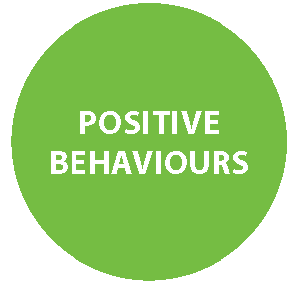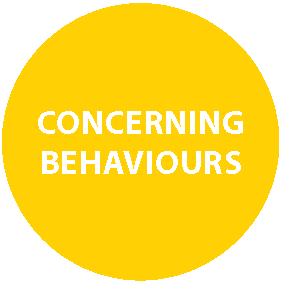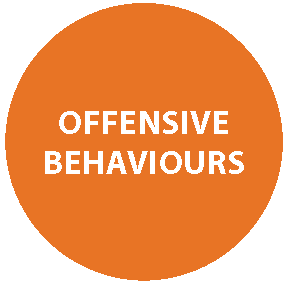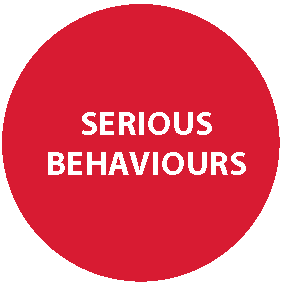Respectful workplace
City employees are expected to behave in a respectful manner in all interactions, and to speak up if they see something inappropriate.
On this page
Immediate safety concern
- Remove yourself
- Call 9-1-1
- Contact City of Calgary Corporate Security at 403-268-8868
- Report the incident online
Create a respectful workplace
The first step to creating a respectful workplace is understanding what behaviours are appropriate and inappropriate. Consider how your own actions may affect those around you.

Professional behaviour that models the 4Cs and contributes to a respectful, safe and healthy workplace.
Example behaviours:
- Polite and courteous
- Open to ideas and opinions
- Being inclusive
- Being an ally
- Using chosen pronouns
- Sincerely apologizing
- Expressing appreciation
- Coaching and mentoring
- Using greetings, asking about others’ well-being
- Respecting and valuing others’ differences

Disrespectful, impolite behaviour that reflects poor judgement and can affect the workplace.
Example behaviours:
- Careless humour or sarcasm
- Incivility, rudeness
- Interrupting
- Yelling and shouting
- Insults and put downs
- Preventing input
- Gossiping
- Excessive profanity
- Taking credit for someone else’s work

Behaviour that requires immediate action and should be reported to your leader or Human Resources.
Example behaviours:
- Bullying, harassment
- Deliberate exclusion from work
- Threats or intimidation
- Abuse of authority
- Unwelcome comments, jokes that humiliate
- Practical jokes or sarcasm that result in embarrassment or awkwardness
- Targeted, repeated yellow zone behaviours

Very serious violation of the Respectful Workplace Policy, Workplace Violence or other City policies.
Example behaviours:
- Racism
- Harassment based on gender
identity, gender expression - Sexual harassment and assault
- Concerns against senior
City leaders - Displays of pornographic,
racist, offensive materials - Unwelcome comments or
jokes relating to a person’s
age, gender, disability, sexual
orientation, etc. - Targeted, repeated orange
zone behaviours
Steps to handle a respectful workplace concern
If are affected by inappropriate workplace behaviour, use the following steps to help you navigate the situation.
Conflict resolution conversation starters
Tips to help you prepare for challenging conversations.
Self-assessment
- I am open to considering my contribution to this conflict.
- I am ready to increase my self-awareness and examine my self-limiting behaviours.
- I am committed to constructively engaging in this conversation to achieve a resolution that works for both of us.
Prepare
- What is the purpose of the conversation? What do you hope to accomplish?
- What assumptions are you making about the person’s intentions? Be cautious not to assume that your assumptions are their intentions.
- What buttons of yours are being pushed? Are you more emotional than the situation warrants? What personal history is being triggered?
- How is your attitude toward the conversation influencing your perception of it? If you think it will be difficult, it will be….if you believe some good will come out of it, it probably will. What adjustments do you need to make before the conversation?
- What are your common needs/fears? Are there common concerns/could there be common concerns?
- How have you contributed to the issue? How has the other person?
Steps for a successful outcome
The majority of the work in any conflict situation or conversation is work you do on yourself. You will need to stay in charge of yourself, your purpose, your emotions and emotional energy during the conversation.
Breathe, center yourself, and repeat when you come off center. By staying calm, you will help the other person stay calm.
- Inquiry - go into the conversation with discovery and curiosity. Try to learn as much about the other person's point of view. Watch body language, listen for unspoken energy. What does the person want? What is the person not saying? Don’t interrupt, let the other person finish what they are saying.
- Acknowledgment – means showing that you've heard and understood. Understanding isn't agreement. “This sounds really important to you…” Acknowledge whatever you can, including your own defensiveness if it comes up, “I notice I’m becoming defensive…I just want to talk about this topic…”
- Advocacy - once the other person has expressed their views, what can you see from your perspective that was missed? Help clarify your position without minimizing the other person's, “From what you’ve told me, I can see how you thought I wasn’t a team player….”
- Problem solving - build on solutions - brainstorming and continued inquiry are useful here. Ask the person what they think might work. Find something you like and build on it. If disagreement happens, move back to inquiry.
- Practice. Practice. Practice - with continued practice you will gain skills and the conversation will be easier.
Additional tips and suggestions
- A successful outcome will depend on two things: how you are and what you say. How you are (centered, supportive, curious, problem-solving) will greatly influence what you say.
- Acknowledge emotional energy–yours and the other person's–and direct it toward a useful purpose.
- Know and return to your purpose at difficult moments.
- Don’t take verbal attacks personally. Help the other person come back to center.
- Don’t assume the other person can see things from your point of view.
- Practice the conversation with a friend or trusted colleague before holding the real one.
- Mentally practice the conversation. See various possibilities and visualize yourself handling them with ease. Envision the outcome you are hoping for.
How do I begin?
Conversation openers:
- I have something I’d like to discuss with you that I think will help us work together more effectively.
- I’d like to talk about ____________ with you, but first I’d like to get your point of view.
- I need your help with what just happened. Do you have a few minutes to talk?
- I need your help with something. Can we talk about it (soon)? If the person says, “Sure, let me get back to you,” follow up with them.
- I think we have different perceptions about _____________________. I’d like to hear your thinking on this.
- I’d like to talk about ___________________. I think we may have different ideas about how to _____________________.
- I’d like to see if we might reach a better understanding about ___________. I really want to hear your feelings about this and share my perspective as well.
Definitions and resources
Bullying
A conscious, willful, deliberate and repeated activity marked by an imbalance of power, intent to harm and/or threat of aggression that has a negative effect on a person’s health and safety. Bullying is a form of harassment that can be verbal (name-calling, putdowns, threats), social (exclusion, gossip, ganging up), physical (hitting, damaging property) or cyberbullying (using technology to harass or threaten). Bullying can occur within a peer group or between groups. It can occur at work and outside of work.
Discrimination
Any conduct, comment or action based on a protected ground. This includes:
- Harassment and bullying, when connected to a protected ground: age, ancestry, colour, gender (includes pregnancy, sexual harassment, transgender), gender expression, gender identity, family status, marital status, mental disability, physical disability, place of origin, race, religious beliefs, sexual orientation, source of income, or any other protected ground covered by the Alberta Human Rights Act.
- Practices, policies or systems which have a direct or negative impact based on a protected ground.
- Behaviours, comments or actions to or about an individual or group, which are unwelcome, based on a protected ground and result in a negative or poisoned work environment.
Disrespectful behaviour
Is objectionable or unwelcome conduct with moderate impact, which may or may not have intent to cause harm and has a negative effect on the work environment or individual(s).
Diverse workforce
A workforce composed of unique individuals with diverse identities, backgrounds, individual characteristics, and perspectives.
Harassment
Is any single significant incident or repeated incidents of objectionable or unwelcome conduct, comment, bullying or action by a person that the person knows, or ought reasonably to know, will or would cause offence or humiliation to an individual and/or a negative effect an individual’s health and safety.
Inclusive workplace
A Workplace where employees welcome, support, respect, and value individuals and treat everyone fairly and equitably, by taking into account individual differences.
Leader
A Leader means a person who is in a position of directing employees and/or work relating to any City Workplace, project, contract, or volunteer operation. They have job titles such as Chief Administrative Officer, General Manager, Director, Chief, Manager, Deputy, Leader, Supervisor, Captain, Team Lead, Superintendent, Foreman, Lead Hand, Coordinator or similar. This includes those temporarily acting in a Leader role or has been delegated a Leader’s duties.
Protected grounds
The Alberta Human Rights Act provides protection from discrimination or harassment on the following grounds: age, ancestry, colour, family status, marital status, mental disability, physical disability, place of origin, race, religious beliefs, sexual orientation, source of income, gender (including pregnancy, sexual harassment or transgender), gender identity and gender expression.
Sexual harassment
Is any unwelcome behavior, comment or conduct that is sexual in nature and negatively affects, or threatens to affect a person, either directly or indirectly. Sexual Harassment is considered a type of gender discrimination under the Alberta Human Rights Act. Examples include:
- Unwelcome advances, requests, comments, physical contact such as unnecessary touching, pinching, patting, jostling or gestures that are sexually suggestive;
- Leering that is sexual in nature;
- Implied or expressed threats of reprisal for refusal to comply with a sexual request; and/or,
- Implied or expressed promise of reward for agreeing to comply with a sexual request.
Violence
Whether at a Workplace or work-related, Violence means the Threatened, attempted, or actual conduct of a person that causes or is likely to cause physical or psychological injury or harm, and includes domestic or sexual Violence.
Workplace
Any location where City work is being or may be conducted including work-based social gatherings. A workplace can include City buildings, vehicles, off-site meetings, customer sites and telework locations.


